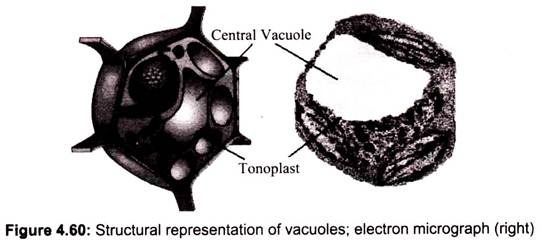Vacuoles (means “empty space”) are cavities in the cytoplasm (especially in plant cells) surrounded by a cytoplasmic membrane, the tonoplast, and filled with a watery fluid called the cell sap containing water and various substances in solution or suspended state. Plants cells have very large distinct vacuoles while in animals, vacuoles are smaller in size. The Plant vacuoles tend to be so large that they push all other organelles against the cell wall.
In plant cells vacuoles may occupy 80% or more of the volume of the cell. A cell may have one or two, small or large vacuoles. The presence of the vacuole is a very conspicuous feature of mature plant cells. They occur in cytoplasmic matrix of the cell starting off as a few small vacuoles in young plant cells. These vacuoles grow and merge as the cell matures (Fig. 4.60).
Vacuole is membrane-bound organelle with little or no internal structure but they serve several functions. Plant cells use their vacuoles for transport and storing nutrients, metabolites, and waste products. The membrane surrounding the plant cell vacuole, tonoplast, is a very active and dynamic membrane. As a membrane, it mainly involved in regulating the movements of ions around the cell, and isolating materials that might be harmful or a threat to the cell.
Transport of protons from the cytosol to the vacuole stabilizes cytoplasmic pH, while making the vacuolar interior more acidic creating a proton motive force which the cell can use to transport nutrients into or out of the vacuole. Proteins found in the tonoplast (aquaporins) control the flow of water into and out of the vacuole through active transport, pumping potassium (K+) ions into and out of the vacuolar interior.
The salts present in vacuoles add to the osmotic activity of the vacuole therefore contributing to the turgor pressure. Turgor pressure exerted by vacuoles is required for cellular elongation- as the cell wall is partially degraded by the action of expansions, the less rigid wall is expanded by the pressure coming from within the vacuole. It is also essential in supporting plants in an upright position. Another function of a central vacuole is that it pushes all contents of the cell’s cytoplasm against the cellular membrane and thus keeps the chloroplasts closer to light so that the light absorbing efficiency is improved.
Vacuoles store organic acids, carbohydrates, proteins, and minerals. Some of these compounds are important for human nutrition like simple sugars such as sucrose found in many fruits, the stems of sugarcane, and the roots of sugar beets. In the leaves and stems of forage grasses, vacuoles store complex polysaccharides that are the principal energy source for herbivores. The other compounds found to accumulate in vacuoles include anthocyanin pigments, alkaloids, enzyme inhibitors, and toxins. Waste products and xenobiotic, including herbicides, are often shuttled into vacuoles by specialized membrane transporters. Once in the vacuole, these compounds are digested or detoxified. They also aid in destruction of invading bacteria or of mis-folded proteins.
Vacuoles of certain specialized cells can store products such as rubber and opium. The contractile vacuoles found in animal cells play an important role in the excretion of water and salts. Fresh water protozoans exhibit the presence of one or two contractile vacuoles that take part in osmo-regulation.
